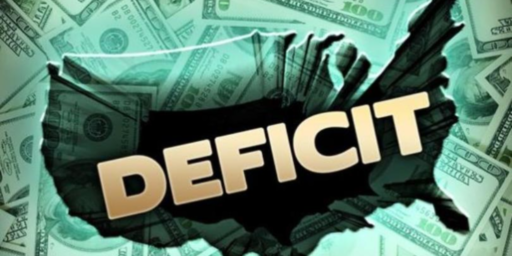Bush May Meet Vow To Halve The Deficit Three Years Early
Investor’s Business Daily reports that President Bush might achieve his promise of halving the deficit three years ahead of schedule.
Aided by surging tax receipts, President Bush may make good on his campaign pledge to cut the deficit in half in 2006 — three years early.
Tax revenues are running $176 billion, or 12.9%, over last year, the Treasury Department said Monday. The Congressional Budget Office said receipts have risen faster over the first eight months of fiscal ’06 than in any other such period over the past 25 years — except for last year’s 15.5% jump. The 2006 deficit through May was $227 billion, down from $273 billion at this time last year. Spending is up $130 billion, or 7.9%.
The CBO forecast in May that the 2006 deficit could fall as low as $300 billion. Michael Englund, chief economist of Action Economics, has long expected a deficit of about $270 billion this year. Now he thinks there’s a chance the “remarkable strength in receipts” will push the deficit even lower.
With the economy topping $13 trillion this year, a $270 billion deficit would equal less than 2.1% of GDP, easily beating the president’s 2.25% goal. Bush made his vow when the White House had a dour 2004 deficit forecast of 4.5% of GDP, or $521 billion. The actual ’04 deficit came in at $412 billion, or 3.5% of GDP, before falling to $318 billion, or 2.6% of GDP, in 2005.
Of course, it should be noted that this is a drop from the 2003 high, not from when Bush took office. Indeed, he inherited a small budget surplus. Granted, the dot.com bubble had burst and the windfall in government tax revenues Clinton enjoyed in the later part of his administration was over. Further, 9/11 and the resultant war on terrorism, including a controversial and phenomenally expensive war in Iraq, is the major reason for the spike in spending. But there has been little fiscal restraint, to put it mildly, even on the discretionary domestic programs that Republicans claim to oppose.
And, regardless of spending priorities, a return to surplus is unlikely:
While economic growth is producing impressive tax revenue gains, budget experts say they won’t be enough to wipe out deficits, especially as baby boomers retire. Englund thinks the deficit could hit $150 billion if the expansion lasts two or three more years. “When we go into a downturn, the numbers reverse,” he said. Long-term growth in Social Security, Medicare and Medicaid “threaten to force either European-style tax increases, unprecedented spending cuts or unprecedented debt,” said Heritage Foundation budget expert Brian Riedl. “There’s no growing out of the long-term budget problems.”
Heritage sees an $800 billion deficit in 2016, assuming tax cuts are extended and spending stays on its present course. If the economy and tax receipts continue to outperform, the deficit would still be at least $600 billion, Riedl said. He noted Congress has been more disciplined about discretionary spending lately. But that saves a mere $10 billion a year, he said.
Despite all the fuss over foreign aid, pork, illegal aliens, and all the rest, the real money in the federal spending picture is relegated to two large buckets: Defense and Entitlements. Neither of those is likely to absorb much of a cut in the near term.





Where in all those statistics do we get reduced by half by 2006? The closest I come is using the BS White House forecast of $521 billion from 2004 combined with Action Economic’s forecast for this year of $270 billion, and that’s still not half.
Ugh,
If you haven’t noticed, the economy is growing. Rather nicely, thanks for asking. The half is a deficit that represented 4.5% of the GDP being reduced to a deficit representing 2.1% of GDP.
Think of it this way. At one point, a $20 million dollar deficit would have bankrupt the country. We have improved our economy over the last 2000 years. So with the variable value of money, pegging the deficit to a percentage of GDP is a more realistic way to look at it.
Yea, and to think of it another way, actual liabilities of 66 trillion and growing! What’s that, 500-600% of GDP?
Now I know what he meant by “I hope I die before I get old.” That way you won’t have to pay any of it back. Cool.
Hope you don’t have any kids.
No, he made the promise when the deficit was 412 billion. Half would be 206 billion. It is already 227 billion this year, as of May.
Hello people,,,trying to spin a line is one thing, but when you got the numbers right in front of you?
And of the two, note, please that the former is the only one that is constitutionally mandated.